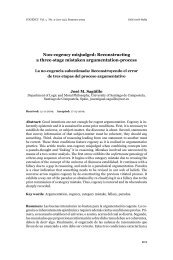Cogency v2 n2
Cogency v2 n2
Cogency v2 n2
You also want an ePaper? Increase the reach of your titles
YUMPU automatically turns print PDFs into web optimized ePapers that Google loves.
COGENCY Vol. 2, N0. 2, Spring 2010<br />
ture. The discussion started by the previous articles is continued in James<br />
F. Klumpp’s “Warranting Arguments, the Virtue of Verb” and Robert C.<br />
Pinto’s “Evaluating Inferences: The Nature and Role of Warrants”.<br />
Klumpp starts from what he takes to be an inherent tension in Toulmin’s<br />
work: Toulmin presented the elements of an argument (data, warrant, backing,<br />
claim, qualifier, and the rebuttal) on the one hand, from the perspective<br />
of labeling the respective parts as statements. These are typically taken<br />
to express propositions. On the other hand, he presented them from the<br />
functional perspective of describing how claims are established. Klumpp<br />
argues that Toulmin’s reconceptualization of argument<br />
[…] reaches its full potential to move from an idealized to a working logic<br />
when the requirement to cast arguments into propositions is also left<br />
behind and the layout deployed as a method of portraying the underlying<br />
movement of reasoning. Thus, presenting the key term of the layout—the<br />
warrant—as a verb, the part of speech capturing movement, best<br />
actualizes the working logic. (p. 104)<br />
Klumpp then goes through seven different characterizations of warrants<br />
and argues that, ultimately, the approach of understanding warrant as a<br />
verb, through the activity of warranting, provides pedagogically the best way<br />
to separate warrants from data. He reports that students immediately grasp<br />
new ways to approach the entitlement provided by the warrant and understand<br />
the procedural nature of real-life argumentation. While I am highly<br />
sympathetic to these concerns, and would also stress the fact that understanding<br />
different functions of arguments paves the way for better understanding<br />
of argument and its value to us, I do not see how this alters the fact<br />
that warrants can be expressed as propositions. It is the truth/justification/<br />
rational acceptability of these propositions, given the backings we have, that<br />
we try to assess.<br />
In his article, Pinto views warrants as material inference rules and offers<br />
an over-arching theory of good arguments, based on the ideas that good<br />
arguments are entitlement-preserving, and that they legitimate the claims<br />
in proportion to the evidence provided by the argument. Pinto’s approach<br />
builds on David Hitchcock’s work and develops the idea that warrants are<br />
162








